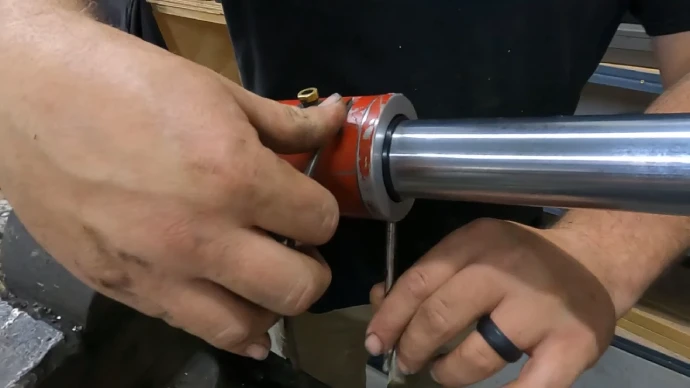Last Updated on March 14, 2023
Leaking hydraulic fluid is a common problem among automotive mechanics and homeowners who use car lifts in their home garages as part of their work.
It is typically caused by five issues: damaged piston seals, loose connections such as hoses and pipes, an overfilled reservoir, damaged hydraulic lines and a hydraulic pump.
Quick action is essential to mitigate the long-term risks posed by a hydraulic fluid leak. Locate and address the source of any such leakage as soon as possible, or risk serious damage being inflicted on your car lift’s vital components over time.
You can fix the underlying cause of your car lift’s hydraulic leak with enough knowledge of its parts. Let’s dive into why your car lift has been experiencing hydraulic fluid leakage and potential solutions to ensure your lift remains running smoothly.
Why Does Your Car Lift Leak Hydraulic Fluid: All Causes
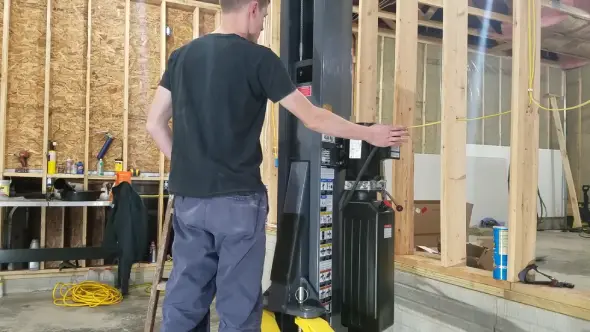
The hydraulic fluid in a car lift is responsible for the smooth movement of the lift. Unfortunately, these fluids can become contaminated or leak due to various causes, leading to a wide range of issues that can be difficult to diagnose and repair.
1. Damaged or Worn out Piston Seals:
Piston seals are the most common cause of a vehicle lift fluid leak. These seals help maintain the pressure and keep hydraulic fluid contained within the hydraulic lines, hoses, and cylinders.
Over time, these seals can become worn out due to age, heavy use, or exposure to contaminants such as water, dirt, and air. When this happens, hydraulic fluid will begin to escape from the piston seal and eventually cause a leak.
2. Loose Connections:
Another possible cause of a car lift fluid leak is loose or damaged connections in the hydraulic system. Car lifts employ several hoses, pipes, and connectors that enable the proper circulation of hydraulic fluid throughout the system.
It causes friction against surfaces leading them to weaken over time until eventually, they become loose enough for fluid to escape from them. If any of these components are loose, this can lead to leaks.
3. Overfilled Reservoir:
The reservoir is an important component of any car lift as it acts as a storage unit for hydraulic fluid. If you overfill the oil reservoir beyond its maximum level mark, then hydraulic fluid may overflow.
The reservoir tank is designed so that when there are no longer items running through its chambers, it will release pressure through valves, so that excess liquid does not build up. If these valves become blocked due to excessive dirt being present in either mechanical element within the machine itself, then this will prevent pressure from properly releasing.
As a result, the liquid will be forced into hose systems leading away from reservoir tanks. It starts leaking from different areas within your hydraulic system, including the reservoir fill cap, drain plug, filter housing, and other joints along the line.
4. Damaged Hydraulic Lines or Hoses:
Damaged hydraulic lines or hoses are another common source of hydraulic fluid leakage in car lifts. These vital components can easily become cracked, punctured, or otherwise damaged due to excessive use or environmental factors such as extreme weather conditions.
5. Worn Out Hydraulic Pump:
The last major culprit behind leaking hydraulic fluid in car lifts is a worn-out Hydraulic pump. The pump within a car lift system is responsible for controlling the flow of hydraulic fluid across all its components, including hoses and valves, enabling it to operate in its intended manner.
Over time this component will start to wear out due either to age or lack of maintenance, causing it not to be able to maintain pressure throughout the system. It results in leaks occurring at different locations where joint seals have weakened or failed completely.
How to Fix Car Lift Leak Hydraulic Fluid?
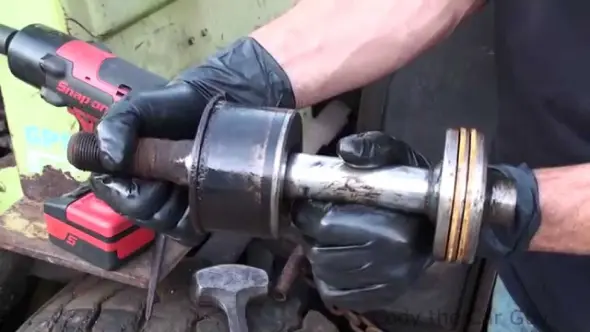
When hydraulic fluid starts leaking from the lift, it is essential to investigate and address the problem quickly in order to ensure that the lift can continue functioning safely and efficiently. If you’re looking for a professional way to fix your car lift leak, this guide should help.
1. Replacing Damaged Piston Seals:
The first step in replacing a damaged car lift piston seal is disconnecting the power source from the lift. Before beginning any repair, it is important to ensure that the area is clear of debris and obstructions.
Use the wrench to disconnect the line from its hydraulic cylinder. Place an appropriate container close by to capture any escaped liquid or oil during removal.
Once this has been done, remove the retaining nuts or bolts holding the old piston seal. Using an O-ring pick tool or other tools, carefully loosen each nut or bolt until it can be removed without damaging the surrounding area.
After all of them have been removed, using a screwdriver or snap ring pliers, carefully pull out the old piston seal from its housing and discard it properly. Then, insert the new seal into its designated position within the housing and secure it with your kit’s new nuts or bolts. Be sure to tighten them securely as loose fasteners could lead to potential malfunctions.
Replacing piston seals requires some specific tools, including an O-ring pick tool and snap ring pliers, so it’s best to leave this job to a professional unless you have experience with this type of work.
2: Replacing Loose Connections:
Check for loose connections such as hoses, pipes, and connectors leading to and from the hydraulic pump reservoir. Also, check related components of your car lift, such as valves or pumps etc.
Tighten connections across your car lift system with adjustable wrenches that properly fit onto each nut or bolt until these fasteners are comfortably secured in place.
Start by draining off all fluid from both sides of the affected connection point before beginning work on it (it also helps prevent messes). Ensure there are no other sources of pressure on either side before disconnecting anything else as this could cause hazardous conditions if not addressed beforehand.
Inspect both sides of the connection point along with any associated clamps or nuts/bolts used to secure them together for signs of corrosion/wear & tear. This will help determine what needs replacing before actually getting into the replacement procedure itself also, check around surrounding areas just in case.
Before removing existing pieces, double check size compatibility between old and new parts being used. Making sure they fit correctly is key here, so take your time & get this part right.
Now carefully loosen & remove whatever nuts/bolts were securing old pieces together. Then use an appropriate tool such as a wrench or pliers depending on the situation in order to do the same for the existing hose/pipe itself.
Install new hose/pipe section(s), followed by securing clamps/nuts/bolts necessary for proper function. checking tightness periodically afterward until the job is complete would also be wise here. Reattach previously disconnected ends back together, too, and you’re done.
3: Reducing Hydraulic Fluid Level in the Reservoir:
Drain some excess hydraulic fluid from the reservoir until it reaches its appropriate oil level mark before continuing with the operation or repairs on your car lift system. You may also want to inspect the reservoir for any signs of damage, as overfilling can cause pressure to build up and damage the system.
4: Replacing Damaged Hydraulic Lines:
To safely disengage, carefully lower the unit and release all built-up hydraulic pressure from the system. Detach all existing lines from their fittings at both ends of each hose assembly. Once they have been loosened up, use pliers or a wrench to unscrew each fitting entirely before discarding them properly.
Afterward, inspect each hose for any ruptures or leaks before proceeding with the installation of new hoses assembled with hose clamps provided upon purchase of your kit. Align each end of every hydraulic hose into its respective fitting until the secure connection is made between both parts using standard hand tools such as wrenches or screwdrivers.
Reconnect all corresponding lines leading from one component over another within your car lift system to ensure safe operation before continuing use further down below.
5. Replacing Damaged Hydraulic Pump:
Drain all the engine oil from the old pump before uninstalling it. This can usually be done by loosening the drain plug at the bottom of the pump housing. Once all of the oil has been drained off, it is important to dispose of it properly by local regulations.
After emptying out the old oil, unscrew any bolts connecting the pump to its mounting bracket or other components to disconnect it from its power source. If any hoses are connected to the pump, they must also be disconnected before complete removal.
Once the old pump has been removed, clean any debris that may have gotten into the system during the removal process. It is also recommended that any interior surfaces where new seals will come into contact are wiped down with an appropriate solvent-free cleaning solution before installing new parts.
Install any new seals or gaskets necessary to reassemble your system according to the manufacturer’s instructions. Ensure they are firmly in place before continuing to install new components.
Now you are ready for the installation of your new hydraulic pump. Take care not to damage any internal components while installing, as this could lead to improper operation down the road if left unchecked.
Once installed, ensure all bolts are tightened securely and check for fluid leaks from any connections made during the installation process.
Signs of a Hydraulic Fluid Leak of a Car Lift
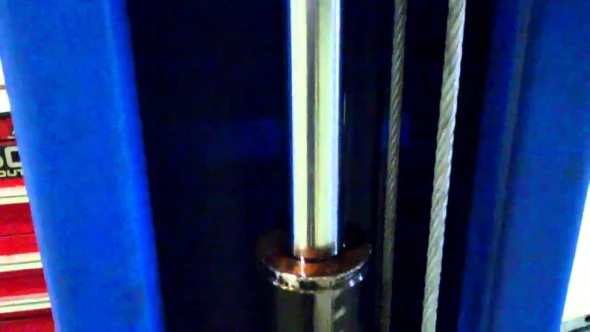
1. Oily Residue Around the Pump Shaft:
A common sign of a hydraulic fluid leak in a car lift is an accumulation of oily or greasy residue around the pump shaft. This oil will have a distinct smell and color, making it easy to identify. It is particularly noticeable when the car lift has been in use for an extended time.
2. Falling Fluid on the Floor:
Another sign of a hydraulic fluid spill in your automotive lift is falling fluid on the floor below where you are working on it. This is usually caused by one or more worn seals or hoses that allow fluid to escape when pressure builds up inside the car lift’s system.
This escaping fluid will form pools on the floor beneath the area where you are working, and its distinctive smell and color make it easy to identify as hydraulic fluid leaking from your car’s hydraulic lift.
3. Decrease Performance:
Decreased performance from your car lift is yet another common symptom of a hydraulic leak. When hydraulic hoses become worn or connectors become loose, air can enter the system, reducing pressure within it. It causes fluids to escape through cracks or other points where they shouldn’t be able to pass through freely.
This leads to inadequate lubrication within the system, which can cause components such as cylinders and pistons to seize up over time. It results in slower operation times for your car lift overall and inaccurate readings from sensors connected throughout its interior systems.
Is It Normal for Hydraulic Fluid to Leak?
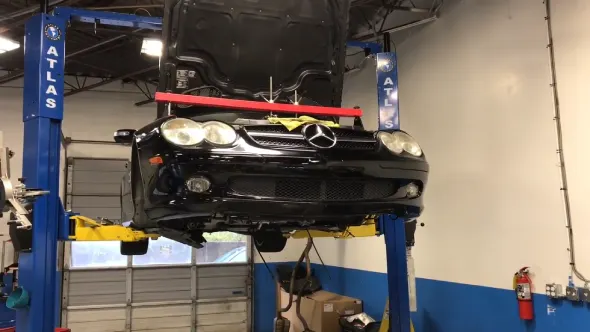
Leaking hydraulic fluid or oil is never a common and good sign and should be treated as an urgent matter. It is not something that should be overlooked or neglected, as any leaking fluid can lead to serious damage or safety risks.
The cause of the leak can be due to a multitude of reasons, such as damaged piston seals, loose connections, faulty hydraulic pumps and lines, and an overfilled reservoir.
Therefore, it is essential to conduct regular maintenance and inspections of your hydraulic system in order to keep it at optimal performance levels. If you find that there are signs of leaking fluid present within your system, then it’s time to investigate what the root cause might be in order to address and rectify it accordingly.
Is There an Additive to Stop Hydraulic Leaks?
There are a variety of additives that can be used to address hydraulic leaks. One such product is Lucas Hydraulic Oil Booster & Stop Leak which offers a variety of benefits when added to your hydraulic system.
This additive renews the oil within the system and helps stop seal leaks while boosting pressure and reducing operating temperatures. The product can also increase the life of hoses, arms, and cylinders while restoring full pressure in worn systems.
Can You Over Tighten Hydraulic Fittings?
If hydraulic fittings are overtightened they may become damaged or deformed which can cause seal failure or other problems with your system. This is why it is important to follow the manufacturer’s instructions when installing new components as well as use the correct tools for tightening fittings.
Overtightening can cause damage to o-rings or gaskets which will result in additional internal leakage. So you should always ensure fittings are tight but not too tight when installing them on your system.
What Color Is Hydraulic Fluid When It Leaks?
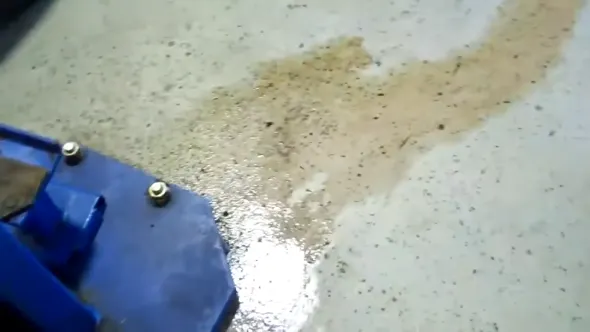
Typically hydraulic fluid has a light amber color and may appear red when leaked onto the pavement or other surfaces due to oxidation from air exposure. However, the exact color will depend on the type of fluid being used in your system, as most manufacturers offer several varieties designed specifically for different applications.
Quickly Spot Leaking Hydraulic Fluids from Your Car Lift for Optimal Performance
Leaking hydraulic fluid from your car lift can be inconvenient and costly if not taken care of properly. Fortunately, with proper maintenance and awareness of potential problems, most car lifts rarely have issues with hydraulics leaking.
Always pay attention to any changes in performance or any wet spots around the vehicle, as these may be signs of a possible leak that needs attention right away before further damage occurs. Taking care of the issue quickly can save time and money in repairs down the road.
